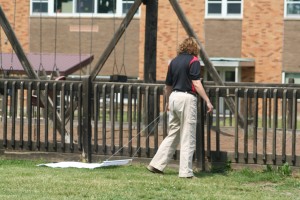The NYS Department of Health has organized a website with extensive information on school environmental health, defined as the way the physical environment of school buildings and school grounds influences the overall health and safety of occupants. The key role that IPM plays in protecting school children and staff is prominent and includes resources from the NYS IPM Program. If you have not visited the site in a while, check it out at https://www.health.ny.gov/environmental/indoors/healthy_schools/index.htm
Tag Archives: NYSIPM
Your First Line of Defense: Walls, Windows, Roofs, and Eaves
“It is December, and nobody asked if I was ready.” – Sarah Kay
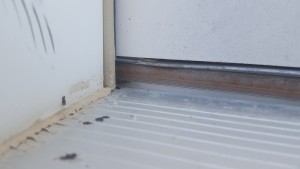
Exclusion takes constant vigilance. Evidence of mice can be found outside this well sealed door.
Winter has officially set in with temperatures in the single or even negative digits. It might seem a bit late for pest-proofing, but some pests are still on the move. Cold-blooded insects such as boxelder bugs, brown marmorated stink bugs, and multicolored asian lady beetles are tucked away for the winter. Preventing warm-blooded pests that are still out in the cold from entering is good IPM. Acting now can also prevent early spring infestations from mammals and birds attempting to nest in your building.
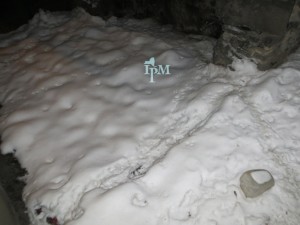
Even in harsh winter conditions, rats must forage for food. These trails highlight that rodents will follow known paths. Notice the large area of undisturbed snow in comparison to the few sets of tracks.
A light snow cover that lasts for a few days can help your inspection efforts by showing evidence of mammals attempting to enter the building. If you find tracks and droppings, carefully inspect those areas to identify why animal signs are concentrated in that area. Chew marks can show where mammals are attempting to break through into the building.
You can also take advantage of the bare tree limbs to inspect higher parts of the building such as rooflines for signs of possible access.
If you find any issues, take steps to exclude pests.
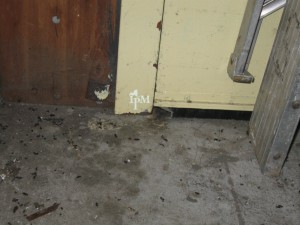
Rodents can chew through thin-bristle brush door sweeps, allowing pest entry.
- Replace door sweeps that are no longer filling the gap
- Seal openings with exclusion products such as sheet metal, hardware cloth, rustproof “steel wool” replacement products, and flexible sealants
- Keep foundation perimeter free of debris
- Keep gable, soffit, roof, and other vents in good repair and made with animal-resistant materials and design
- Prune tree branches to be no closer than ten feet from a building
For more information on excluding pests, visit Best Management Practices for School IPM: Indoor BMPs: Structural: Walls, Windows, Roofs, Eaves and Beasts Begone! A Practitioner’s Guide to IPM in Buildings.
Ticks: Assessing the risk at schools and child care centers
“I tried real hard to play golf, and I was so bad at it they would have to check me for ticks at the end of the round because I’d spent about half the day in the woods.” – Jeff Foxworthy
‘Tis the season for requests for emergency pesticide sprays on school and child care grounds to get rid of ticks. The request is often prompted by an irate parent who found a tick on their child.
Problem #1: IPM requires evidence, not complaints, to determine when management should take place. When looking for an exemption to apply pesticides under the Child Safe Playing Fields Act, confirmation that ticks are on the property is essential.
Problem #2: playgrounds and ball fields are lousy tick habitat. As Jeff Foxworthy discovered, golfers who stay on fairways are in little danger of picking up ticks. While it’s always possible a tick dropped off a wandering deer, mouse, or bird, it’s not likely to survive in a dry place for long. Mowed lawn and mulched playgrounds don’t typically have the 85% relative humidity level ticks need to survive.

It’s not easy to tell if a tick has been feeding for up to two days after it starts. But — be aware. This is only an estimate.
Problem #3: ticks are sneaky. Very sneaky. Their entire livelihood depends on being attached to another living being for up to a week without being discovered. A tick found today provides little information about where it was picked up.
But guidance is available. The TickEncounter Resource Center has growth charts showing how a tick’s appearance changes the longer it is able to feed. If you send them a picture, they can determine how long the tick has been feeding.
Still, be aware: this is only an estimate.
The upshot is that ticks found on students shouldn’t trigger pesticide applications on playgrounds. But they should trigger the IPM practice of tick monitoring. The easiest way to look for ticks? Dragging.
Tick drags are easy and inexpensive to make. Attach dowels on the ends of a 3’x3’ white flannel cloth and tie a string to each end of one of the dowels. Drag the cloth over grass for 30 seconds. Identify and count the number of ticks clinging to the sheet. Repeat over the entire area. Woods and shrubby areas are easier to scout with a tick flag, which is simply a tick drag with only one dowel attached. Instead of dragging, swipe the bushes and understory with the flag. Everything else remains the same. Done often wherever kids play, you can assess the risk of picking up ticks year-round. According to School Integrated Pest Management Thresholds, the recommended threshold for action for ticks is three ticks in outdoor student activity areas.
Did tick monitoring indicate that the tick population is above threshold on portions or all of your grounds? You can find management practices and more in our fact sheet, Understanding and Managing Ticks – A Guide for Schools, Child Care and Camps.
Looking for more information? Visit Don’t Get Ticked NY.
Pesticide Misapplications? The Costs Are High
A chemical smell wafting through an upstate middle-school classroom last fall ended up sending six students to the hospital. What happened?
A member of the custodial staff sprayed wasp killer by a fresh-air intake. Some of that spray ended up in a second floor classroom. Fourteen students and two staff members felt ill, according to a newspaper account; in fact, the school was evacuated for more than a half hour.

Need help identifying a pest and what to do about it? What’s Bugging You? has the information you need.
The school was fined $5,500 for violating three pesticide regulations. But incidents like this are preventable by practicing integrated pest management.
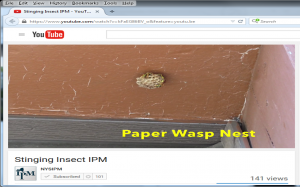
The NYS IPM Program offers resources such as this video about stinging insects and IPM strategies that reduce the risk of stings.
Many state regulations pertain to pesticide use in and around schools. You can find a synopsis here. But first and foremost — anyone who applies pesticides on school property must meet pesticide application certification requirements. (The same applies to child care centers, office buildings, or any other commercial or public property.) If the certified applicator is a school employee, then the school itself must be registered and appropriately insured.
Neither the school’s pesticide-application notification requirements nor the Child Safe Playing Fields Act were violated, since each provides exemptions for the use of small containers of aerosol products in an imminent threat from stinging and biting insects. Regardless, a certified pesticide applicator must apply them, and, if applied by a school staffer, the school must be registered.
School staffers can obtain and maintain commercial pesticide licenses after getting the right education credits and passing their exams. You can find information about pesticide certification on the Pesticide Safety Education Program website, including information about upcoming classes.
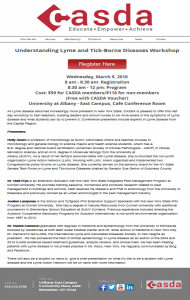
Organizations such as BOCES and CASDA often ask NYS IPMers to present at their conferences, such as this upcoming workshop on ticks and tick-borne diseases.
Consider: without the basic knowledge inherent in getting a license, how can you be sure that staff are aware of the laws that keep incidents such as this from occurring? Who will be qualified to choose a pest management contractor when the need to protect students from the threat of pests — whether increased risk of asthma from mice or cockroaches, rashes from poison ivy, or anaphylactic shock from a wasp sting — relies on an expert’s help? And how will school personnel know what steps they can take to not only deal with existing (and potentially costly) pest issues, but also prevent new ones from taking place?
Answer: Be sure your maintenance staff gets the education needed to stay up to date with the latest pest management information.
The New York State Integrated Pest Management Program has resources to help schools with their pest issues. Visit the NYS IPM Program’s school webpage. Learn about specific pests, including stinging insects. Sign up for our blog, The ABCs of School and Childcare Pest Management. Send staff to classes offered by our experts.
We are here to help address your pest management needs.
Pest Management for Today’s Schools Workshop – October 30, 2015
Do you work for a school district served by Orange-Ulster BOCES? Join the NYS IPM Program of Cornell University and Orange-Ulster BOCES for a seminar on implementing integrated pest management within schools and on the grounds.
There is no fee for the workshop, but pre-registration is requested. Contact Jack DeGraw, Health and Safety Coordinator, Orange – Ulster BOCES at john.degraw@ouboces.org or 845-781-4887.
WHERE
AGENDA
8:00 – 8:30 Registration
8:30 – 9:00 Tenets of School IPM – Lynn Braband, NYS IPM Program
Introduction to the concepts and tools for successful integrated pest management programs on school properties. Learn how to make your pest management program more efficient and effective, and how to comply with school-related laws and policies.
9:00 – 9:45 Regulatory Update – Catherine Ahlers, NYS Department of Environmental Conservation
Presentation of state regulations impacting pest management on school properties.
9:45 – 10:00 Break
10:00 -11:00 Turf and Grounds IPM – Joellen Lampman, NYS IPM Program
A discussion of IPM approaches for athletic fields, lawns, and non-turf areas such as fencelines, sidewalks, and curbs. Cultural techniques for minimizing weed populations, such as heavy overseeding, will be featured along with methods for assessing insect populations. Techniques for preventing insect and weed infestations as well as pest management products allowable for use on school grounds will be reviewed.
11:00 – 12:00 Structural Pest Management – Lynn Braband, NYS IPM Program
A description of implementing IPM for management of rodents, ants, cockroaches, and other pests in school buildings. This session will include discussions of inspections, sanitation, prevention, control options for common structural pests, and record keeping.
12:00 – 12:30 Walk-Through Exercise – Lynn Braband and Joellen Lampman, NYS IPM Program
Interactive session where we will conduct a casual on-site inspection, discussing pest management aspects of situations encountered.

